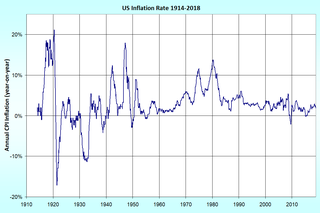
Demand-pull inflation is asserted to arise when aggregate demand in an economy outpaces aggregate supply. It involves inflation rising as real gross domestic product rises and unemployment falls, as the economy moves along the Phillips curve. This is commonly described as "too much money spent chasing too few goods." More accurately, it should be described as involving "too much money chasing too few goods," since only money that is spent on goods and services can cause inflation. This would not be expected to happen, unless the economy is already at a full employment level. It is the opposite of cost-push inflation.
Macroeconomics is a branch of economics dealing with the performance, structure, behavior, and decision-making of an economy as a whole. This includes regional, national, and global economies. Macroeconomists study aggregated indicators such as GDP, unemployment rates, national income, price indices, and the interrelations among the different sectors of the economy to better understand how the whole economy functions. They also develop models that explain the relationship between such factors as national income, output, consumption, unemployment, inflation, saving, investment, international trade, and international finance.
In economics, stagflation is a situation in which the inflation rate is high, the economic growth rate slows, and unemployment remains steadily high. It presents a dilemma for economic policy, since actions intended to lower inflation may exacerbate unemployment, and vice versa.
Monetarism is a school of thought in monetary economics that emphasizes the role of governments in controlling the amount of money in circulation. Monetarist theory asserts that variations in the money supply have major influences on national output in the short run and on price levels over longer periods. Monetarists assert that the objectives of monetary policy are best met by targeting the growth rate of the money supply rather than by engaging in discretionary monetary policy.
The Phillips curve is a single-equation econometric model, named after William
Phillips, describing a historical inverse relationship between rates of unemployment and corresponding rates of rises in wages that result within an economy. Stated simply, decreased unemployment, in an economy will correlate with higher rates of wage rises. Phillips did not himself state there was any relationship between employment and inflation, this notion was a trivial deduction from his statistical findings. Samuelson and Solow made the connection explicit and subsequently Milton Friedman
and Edmund Phelps
put the theoretical structure in place. In so doing, Friedman was to successfully predict the imminent collapse of Phillips' a-theoretic correlation.
In macroeconomics, Aggregate Demand (AD) or Domestic Final Demand (DFD) is the total demand for final goods and services in an economy at a given time. It specifies the amounts of goods and services that will be purchased at all possible price levels. This is the demand for the gross domestic product of a country. It is often called effective demand, though at other times this term is distinguished.
In economics, shock therapy is the sudden release of price and currency controls, withdrawal of state subsidies, and immediate trade liberalization within a country, usually also including large-scale privatization of previously public-owned assets.

Disinflation is a decrease in the rate of inflation – a slowdown in the rate of increase of the general price level of goods and services in a nation's gross domestic product over time. It is the opposite of reflation. Disinflation occurs when the increase in the “consumer price level” slows down from the previous period when the prices were rising.
Neo-Keynesian economics is a school of macroeconomic thought that was developed in the post-war period from the writings of John Maynard Keynes. A group of economists, attempted to interpret and formalize Keynes' writings and to synthesize it with the neo-classical models of economics. Their work has become known as the neo-classical synthesis and created the models that formed the core ideas of neo-Keynesian economics. These ideas dominated mainstream economics in the post-war period and formed the mainstream of macroeconomic thought in the 1950s, 1960s and 1970s.
The 1990 oil price shock occurred in response to the Iraqi invasion of Kuwait on August 2, 1990, Saddam Hussein's second invasion of a fellow OPEC member. Lasting only nine months, the price spike was less extreme and of shorter duration than the previous oil crises of 1973–1974 and 1979–1980, but the spike still contributed to the recession of the early 1990s. Average monthly price of oil rose from $17 per barrel in July to $36 per barrel in October. As the U.S.-led coalition experienced military success against Iraqi forces, concerns about long-term supply shortages eased and prices began to fall.
Neutrality of money is the idea that a change in the stock of money affects only nominal variables in the economy such as prices, wages, and exchange rates, with no effect on real variables, like employment, real GDP, and real consumption. Neutrality of money is an important idea in classical economics and is related to the classical dichotomy. It implies that the central bank does not affect the real economy by creating money. Instead, any increase in the supply of money would be offset by a proportional rise in prices and wages. This assumption underlies some mainstream macroeconomic models. Others like monetarism view money as being neutral only in the long-run.

The economy of Illinois is the fifth largest by GDP in the United States and one of the most diversified economies in the world. The Chicago metropolitan area is home to many of the United States' largest companies, including Allstate, Boeing, Caterpillar, Kraft Heinz, McDonald's, Motorola, United Airlines, Walgreens, and more. The Chicago area headquarters a wide variety of financial institutions, and is home to the largest futures exchange in the world, the Chicago Mercantile Exchange.
Capacity utilization or capacity utilisation is the extent to which an enterprise or a nation uses its installed productive capacity. It is the relationship between output that is produced with the installed equipment, and the potential output which could be produced with it, if capacity was fully used.
Monetary inflation is a sustained increase in the money supply of a country. Depending on many factors, especially public expectations, the fundamental state and development of the economy, and the transmission mechanism, it is likely to result in price inflation, which is usually just called "inflation", which is a rise in the general level of prices of goods and services.

Nixonomics, a portmanteau of the words "Nixon" and "economics", refers to U.S. President Richard Nixon's economic performance. Nixon is the first president to have his surname combined with the word "economics".
NAIRU is an acronym for non-accelerating inflation rate of unemployment, and refers to a level of unemployment below which inflation rises. It was first introduced as NIRU by Franco Modigliani and Lucas Papademos in 1975, as an improvement over the "natural rate of unemployment" concept, which was proposed earlier by Milton Friedman.
Inflation rate in India was 3.78% as of August 2015, as per the Indian Ministry of Statistics and Programme Implementation. This represents a modest reduction from the previous annual figure of 9.6% for June 2011. Inflation rates in India are usually quoted as changes in the Wholesale Price Index (WPI), for all commodities
Fiscal policy and monetary policy are the two tools used by the state to achieve its macroeconomic objectives. While for many countries the main objective of fiscal policy is to increase the aggregate output of the economy, the main objective of the monetary policies is to control the interest and inflation rates. The IS/LM model is one of the models used to depict the effect of policy interactions on aggregate output and interest rates. The fiscal policies have a direct impact on the goods market and the monetary policies have a direct impact on the asset markets; since the two markets are connected to each other via the two macrovariables output and interest rates, the policies interact while influencing output and interest rates.




